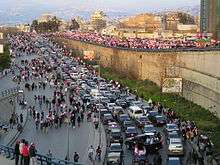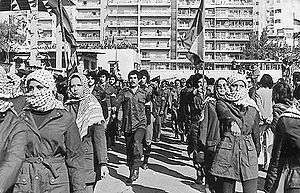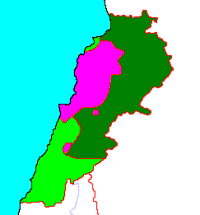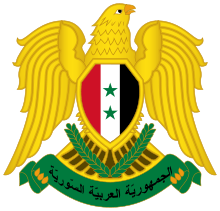Syrian occupation of Lebanon
The Syrian occupation of Lebanon (Arabic: الاحتلال السوري للبنان, French: Occupation syrienne du Liban) began in 1976, during the Lebanese Civil War, and ended in 2005 following the assassination of former Lebanese Prime Minister Rafic Hariri.

In January 1976, a Syrian proposal to restore the limits to the Palestinian guerrilla presence in Lebanon, which had been in place prior to the outbreak of the civil war, was welcomed by Maronites, but rejected by the Palestinian guerrillas and their Lebanese Druze-led and leftist allies. In June 1976, to deal with the opposition posed by this latter group (which was normally allied with Syria), the Syrian government dispatched Palestinian units under its control into Lebanon, and soon after sent in its own troops as well. Syria claims these interventions came in response to appeals from Christian villagers under attack by Leftists in Lebanon.
By October 1976, Syria had caused significant damage to the strength of the Leftists and their Palestinian allies, but at a meeting of the Arab League, it was forced to accept a ceasefire. The League ministers decided to expand an existing small Arab peacekeeping force in Lebanon, but it grew to be a large Arab Deterrent Force consisting almost entirely of Syrian troops. The Syrian military intervention was thus legitimized and received subsidies from the Arab League for its activities.[1]
In 1989, at the final accords of the civil war, two rival administrations were formed in Lebanon: a military one under Michel Aoun in East Beirut and a civilian one under Selim el-Hoss based in West Beirut; the latter gained the support of the Syrians. Aoun opposed the Syrian presence in Lebanon, citing the 1982 UN Security Council Resolution 520.[2] In the resulting "War of Liberation", which erupted in March 1989, Aoun's forces were defeated and he himself exiled from Lebanon. In 1991, a Treaty of "Brotherhood, Cooperation, and Coordination", signed between Lebanon and Syria, legitimized the Syrian military presence in Lebanon. It stipulated that Lebanon would not be made a threat to Syria's security and that Syria was responsible for protecting Lebanon from external threats. In September that same year a Defense and Security Pact was enacted between the two countries.[3]
With the consequent adoption of UN Security Council Resolution 1559 and following the assassination of the Lebanese ex-premier Rafic Hariri in 2005, and the alleged involvement of Syria in his death, a public uprising called the Cedar Revolution had swept the country. Syria completed its full withdrawal from Lebanon on April 30, 2005.[4]
Background
The Lebanese Civil War that began on April 13, 1975 was the backdrop against which the Syrian military presence in Lebanon was established.

In January 1976, its proposal to restore the limits to the Palestinian guerrilla presence in Lebanon, that had been in place prior to the outbreak of the civil war, was welcomed by Maronites and conservative Muslims, but rejected by the Palestinian guerrillas and their Lebanese Druze-led and leftist allies. Syria's interventions came in response to appeals from Maronite leaders, who feared attack by leftists and Palestinians.[1] In a 1976 diplomatic cable released by WikiLeaks, a US diplomat stated "if I got nothing else from my meeting with Frangie, Chamoun and Gemayel, it is their clear, unequivocal and unmistakable belief that their principal hope for saving Christian necks is Syria. They sound like Assad is the latest incarnation of the Crusaders. However, after a confrontation with Lebanese Forces Leader, Bachir Gemayel, the relationship intensified between the Syrian forces and the Maronite leaderships. In 1977, tensions turned into hostility, and the help extended turned in open out conflict between the two parties."[5]
Syrian invasion of Lebanon
On 31 May 1976, The Syrian army began an invasion of Lebanon. 2000 troops and 60 tanks marched in 3 columns during a 3-pronged offensive.[6] The first column marched south across Shuf towards Sidon, where it was halted by PLO forces.[6] The second column moved west along the Beirut - Damascus, before being stopped at Beirut. Another column moved north through the Bekaa valley, before then going west towards Tripoli, where it was stopped by Christian forces.[6] The offensive had been halted by 10 June.[7] A second Syrian offensive in mid-October 1976 succeeded at capturing all of central Lebanon as well as some of the country's most important urban centres.[7]
Occupation period

By October 1976, Syria had caused significant damage to the strength of the leftists and their Palestinian allies, but at a meeting of the Arab League, it was forced to accept a ceasefire. The League ministers decided to expand an existing small Arab peacekeeping force in Lebanon. It grew to be a large deterrent force consisting almost entirely of Syrian troops. The Syrian military intervention was thus legitimized and received subsidies from the Arab League for its activities.[1]
In the late 1980s, General Michel Aoun was appointed President of the Council of Ministers by President Amine Gemayel, a controversial move since Aoun was a Maronite Christian and the post was by unwritten convention reserved for a Sunni Muslim. Muslim ministers refused to serve in Aoun's government, which was not recognized by Syria. Two rival administrations were formed: a military one under Aoun in East Beirut and a civilian one under Selim el-Hoss based in West Beirut; the latter gained the support of the Syrians. Aoun opposed the Syrian presence in Lebanon, citing the 1982 UN Security Council Resolution 520.[8]
The Syrian military remained in Lebanon; after a successful campaign against the Lebanese Forces militia who had controlled Beirut port, Aoun, now with massive popular support in his East Beirut enclave, declared a "War of Liberation" against the Syrian forces.
Attacking Lebanese Army that was led by Michel Aoun began on 14 March 1989. Casualties among civilians on both sides from indiscriminate artillery bombardments across the front line were numerous. Aoun initially received a greater degree of international support than el-Hoss, but this ended abruptly with the American build-up for war with Iraq over Kuwait. Aoun had received considerable support from the Iraqi government, anxious to weaken the rival Baathist government in Damascus; in October 1990 the Syrian forces attacked and occupied the Presidential Palace at Baabda.
Aoun took refuge in the French embassy and was later exiled from Lebanon to France. Circumstances surrounding his exile are controversial; his apprehension and exile are variously attributed to Syrian forces, Israel Defense Forces, Shiite militias, and the Lebanese Forces militia of Samir Geagea.
Since then, Syrian forces remained in Lebanon, exercising considerable influence. In 1991, a Treaty of "Brotherhood, Cooperation, and Coordination", signed between Lebanon and Syria, legitimized the Syrian military presence in Lebanon. It stipulated that Lebanon would not be made a threat to Syria's security and that Syria was responsible for protecting Lebanon from external threats. In September that same year a Defense and Security Pact was enacted between the two countries.[3]
After the Israeli withdrawal from southern Lebanon and the death of Hafez al-Assad in 2000, the Syrian military presence faced criticism and resistance from the Lebanese population.[9]
With the consequent adoption of UN Security Council Resolution 1559 and following the assassination of the Lebanese ex-premier Rafik Hariri and allegations of Syrian involvement in his death, a public uprising nicknamed the Cedar Revolution swept the country. On March 5, 2005, Syrian President Bashar Al-Assad announced that Syrian forces would begin its withdrawal from Lebanon in his address to the Syrian parliament.[10] Syria completed its full withdrawal from Lebanon on April 30, 2005.[11]
Assassinations
Kamal Jumblatt
On 16 March 1977, Kamal Jumblatt was gunned down in his car near the village of Baakline in the Chouf mountains by unidentified gunmen.[12][13][14] His bodyguard and driver also died in the attack.[12]
Prime suspects include the pro-Syrian faction of the Lebanese Syrian Social Nationalist Party (SSNP),[15] in collaboration with the Ba'ath Party. In June 2005, former secretary general of the Lebanese Communist Party George Hawi claimed in an interview with Al Jazeera, that Rifaat al-Assad, brother of Hafez al Assad and uncle of Syria's current President Bashar al-Assad, had been behind the killing of Jumblatt.[16]
Bachir Gemayel
On 14 September 1982, the Lebanese president Bachir Gemayel was addressing a speech in Achrafieh, at 4:10 PM, a bomb was detonated at the headquarters, killing him and 26 other politicians.
Habib Shartouni, a member of the Syrian Social Nationalist Party, was later arrested for the assassination. He was imprisoned for 8 years, until Syrian troops took over Lebanon at the end of the war and freed him on 13 October 1990. Eventually, then-president Amine Gemayel, the brother of Bachir, did not condemn Shartouni because of immense Syrian pressure.
Units involved
Between 1976 and 2005, Syria had on average between 20,000 and 40,000 troops in Lebanon. The major formations deployed in Lebanon were the 47th Armoured Brigade, 62nd Armoured Brigade, most of the 10th Mechanized Division (2 armoured brigades - the 76th and the 91st, 1 mechanized infantry brigade, 1 artillery brigade), plus 5 Special Forces regiments deployed in strategic and tactical locations, and at least 1 Air Defense Brigade. Before 1984, a brigade of the Defense Companies was also deployed in Beirut, Sidon and Tripoli to fight Sunni militias and train pro-Syrian militias. Officers of the Military Intelligence, General Security Directorate and Air Force intelligence were tasked with Syria's administration in Lebanon. Ghazi Kanaan and Rustum Ghazaleh were the two intelligence officers who controlled Lebanon throughout this period.
Diplomatic exchange
In October 2008, both Syria and Lebanon decided to have diplomatic relationships by establishing embassies for the first time in history since both countries gained their national independence during the 1940s. Two months later, the Syrian Embassy was opened in Beirut. In March 2009, Lebanon followed and opened its embassy in Damascus.
Special Tribunal for Lebanon
The Special Tribunal for Lebanon was formed in the wake of the assassination of former Prime Minister Rafic Hariri on 14 February 2005. Following which the Syrian military presence ended on 26 April 2005 after the Cedar Revolution that took place as a reaction to the assassination.
In 2010, as rumours abounded of an indictment to members of Hezbollah and rising tensions, Syrian President Bashar al-Assad visited Lebanon for the first time since the Hariri's assassination along with Saudi King Abdullah.[17]
Political status
Analyzing whether and when the Syrian presence was a military occupation under international law, Gerhard von Glahn writes that "The mandate of the Force was renewed several times before it officially expired on July 27, 1982, at the time of the Israeli siege of Beirut. The Lebanese government refused to request that the mandate be renewed by the Arab League. Instead, in September 1986, Lebanon requested an end to the Syrian presence in Lebanon. It would appear that, lacking legal authority from both Lebanon and the Arab League, Syria's military forces had to be regarded henceforth as illegal occupants of Lebanon."[18]
See also
- Palestinian insurgency in South Lebanon
- Lebanon bombings and assassinations (2004–present)
- List of assassinated Lebanese people
Notes
- Weisburd, 1997, pp. 156-157.
- United Nations Security Council Resolution 520 http://peacemaker.un.org/lebanon-syria-brotherhood-treaty91
- Ginat et al., 2002, p. 196.
- "Retrait syrien total fin avril au plus tard" (in French).
- "Cable: 1976BEIRUT02937_b". Retrieved 10 November 2014.
- Stout, Theodore (2002). "THE SYRIAN INTERVENTION IN LEBANON 1975-76:A FAILURE OF STRATEGY" (PDF). aiswest.com. p. 26.
- Lawson, Fred H. (1984). "Syria's Intervention in the Lebanese Civil War, 1976: A Domestic Conflict Explanation". International Organization. 38 (3): 451–480. doi:10.1017/S0020818300026813. ISSN 0020-8183. JSTOR 2706467.
- "Assad announces Lebanon troop withdrawal". www.theguardian.com. March 5, 2005. Retrieved May 13, 2020.
- "Retrait syrien total fin avril au plus tar" (in French).
- Edgar O'Ballance (15 December 1998). Civil War in Lebanon, 1975-92. Palgrave Macmillan. p. 62. ISBN 978-0-312-21593-4. Retrieved 21 October 2012.
- Tim Llewellyn (1 June 2010). Spirit of the Phoenix: Beirut and the Story of Lebanon. I.B.Tauris. pp. xiii. ISBN 978-1-84511-735-1. Retrieved 15 March 2013.
- Knudsen, Are (2010). "Acquiescence to Assassinations in Post-Civil War Lebanon?". Mediterranean Politics. 15 (1): 1–23. doi:10.1080/13629391003644611.
- "Assassinations in Lebanon: A History (1970s to the Present)". About.com. Retrieved 30 June 2012.
- "George Hawi knew who killed Kamal Jumblatt". Ya Libnan. 22 June 2005. Archived from the original on 7 June 2012. Retrieved 21 July 2012.
- "Assad 'to attend' summit in Lebanon". Al Jazeera English. Retrieved 10 November 2014.
- Von Glahn, Gerhard (1992). Law Among Nations: An Introduction to Public International Law. New York: Macmillan Pub. Co. pp. 687–688. ISBN 0-02-423175-4.
Bibliography
- Ginat, J.; Perkins, Edward Joseph; Corr, Edwin G. (2002). The Middle East peace process: vision versus reality (Illustrated ed.). University of Oklahoma Press. ISBN 9780806135229.
- Weisburd, Arthur Mark (1997). Use of force: the practice of states since World War II. Penn State Press. ISBN 9780271016801.
External links
- The Syrian Occupation of Lebanon
- The Syrian Occupation of Lebanon
- Pining for Freedom: Syrian occupation suffocates Lebanon, and the world shrugs
- Ending Syria's Occupation of Lebanon: The U.S. Role
- Forecast of the Lebanese economy in the post Syrian occupation era
- "SYRIA/LEBANON: The Occupied/Occupied", PBS FRONTLINE/World

